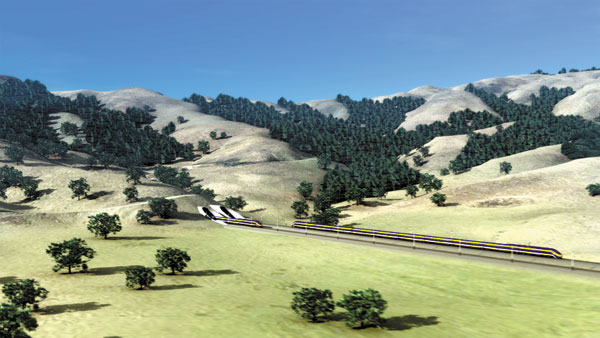A study of possible routes for the California High-Speed Rail
project track recently released eliminated the possibility of a
Gilroy Station Loop that had included two tracks running along U.S.
101 and two running through downtown.
A study of possible routes for the California High-Speed Rail project track recently released eliminated the possibility of a Gilroy Station Loop that had included two tracks running along U.S. 101 and two running through downtown.
However, other previously discussed options along the Monterey Highway-Union Pacific Railroad corridor and options along U.S. 101 between Morgan Hill and Gilroy remain on the table. So do the possibilities of trenched or aerial tracks through downtown Gilroy. Stations continue to be proposed for either Leavesley Road east of U.S. 101 or in downtown Gilroy near the Caltrain station.
The California High-Speed Rail Authority board on Thursday examined possible routes for the San Jose-to-Merced portion of the project following several months of gathering community input. Now, rail officials plan to gather more community input from local residents as they aim to assemble a draft Environmental Impact Report by July 2011.
The $45-billion, 800-mile California High-Speed Rail system, expected to begin full operations in 2020, is slated to have routes from San Diego to Sacramento and to the Bay Area, transporting passengers at speeds of up to 220 mph. A 123-mile stretch from Merced to San Jose would run through the Pacheco Pass and could include a station in Gilroy.
Six potential routes are being considered for Gilroy. A seventh route, the loop route, was eliminated because of environmental impacts, visual impacts and high capital costs.
One option that would run directly east of the Union Pacific tracks through downtown Gilroy would knock down 19 buildings, including an unspecified “National Register Resource.” That resource also would be knocked down if the rail authority were to implement an option that would route the rail from U.S. 101 to east Gilroy.
Those routes also would threaten a row of shade trees planted along the Monterey Highway in the early 1900s that are listed as a California Registered Point of Historical Interest. The trees also would be threatened by a route that runs just east of the Union Pacific tracks and then cuts toward east Gilroy.
The downtown Gilroy option would destroy far more buildings than other alternate routes.
Although routes that head along U.S. 101 or cut over to eastern Gilroy would cause less structural damage, many rural Gilroy residents have been vocal in their opposition of these options.
All the possible routes have the potential of knocking down buildings that are more than 45 years old, according to the study.
The route analysis also notes that Union Pacific has sent a letter to the rail authority that opposes options that are adjacent to its right of way.
“Union Pacific has made its position regarding use of its rights of way for the high-speed rail corridor clear on many occasions,” wrote Jerry S. Wilmoth, Union Pacific’s general manager for network infrastructure, in an April 23 letter to high-speed rail officials. “Union Pacific objects to location of the high-speed corridor so close to UP’s operations as to be a safety hazard. Finally, Union Pacific objects to the location of the corridor so that it takes existing rail-served customers or acts as a barrier to all future rail-served developments.”
Jeff Barker, deputy director of the California High Speed Rail Authority, could not be reached for comment this week.
Yvonne Sheets-Saucedo, a rural Gilroy resident who said has been critical of aspects of the high-speed rail process, said this week that UP’s position on the matter is of critical importance.
“HSRA has not secured the UPRR right-of-way and it is VERY unlikely that they will,” she wrote in an e-mail Monday. “What that means is the East 101 alignment is the ONLY (possible route) and it was NOT studied in the Program (environmental impact report)!”
In addition, she took issue with a lack of studies on noise and vibration impacts of a train traveling at 220 mph and with a 6,300-car parking garage in Gilroy that is slated to accompany the project.
The analysis also provides details on other portions of the San Jose-to-Merced route, nixing a proposal to underground high-speed rail tracks through San Jose.
Gilroy City Councilman Perry Woodward said last week that the voters have approved the project, so the City Council must work with high-speed rail officials to make it as good as it can get.
He had no regrets about hearing that the loop alternative eliminated, as it would have sent two sets of tracks through Gilroy.
“In one sense, that would have been the worst possible outcome,” he said.
At the same time, he wondered about whether it was realistic to continue looking at routes that would cross UP’s right of way.
“Apparently, they’re planning the best-case scenario, which is if UP would allow them to cross their right of way and use the right of way,” Woodward said. “From everything I’ve heard, that’s probably too optimistic.”
The California High-Speed Rail Authority plans to host a meeting with the South County Joint Planning Advisory Committee at 7 p.m. Thursday at the Morgan Hill City Council Chambers, 17555 Peak Ave. in Morgan Hill, and an informational meeting from 6 to 8 p.m. June 28 at the Hilton Garden Inn, 6070 Monterey Road.










